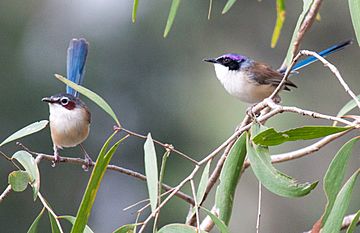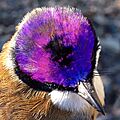Purple-crowned fairywren facts for kids
Quick facts for kids Purple-crowned fairywren |
|
|---|---|
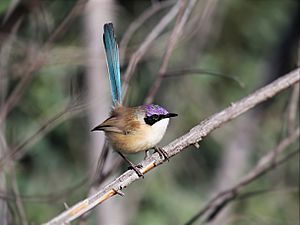 |
|
| Male purple-crowned fairy-wren | |
| Conservation status | |
| Scientific classification | |
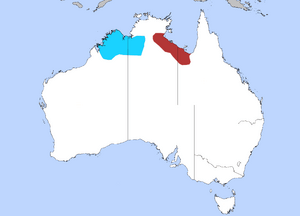 |
|
| Range of M. c. subsp. coronatus Range of M. c. subsp. macgillivrayi |
The purple-crowned fairywren (Malurus coronatus) is a beautiful little bird found only in northern Australia. It belongs to the Australasian wren family, Maluridae. This bird is the largest of the eleven species in its group, called Malurus. Its name comes from the Latin word cǒrōna, meaning "crown". This is because breeding males have a special purple circle of feathers on their heads.
You can tell purple-crowned fairywrens apart from other fairywrens in northern Australia. They have special patches on their cheeks. Males have black cheek patches, while females have reddish-chocolate ones. They also have a bright blue, perky tail.
Contents
Understanding the Purple-Crowned Fairywren Family
The purple-crowned fairywren is one of 11 types of birds in the Malurus group, known as fairywrens. It is closely related to the splendid fairywren and superb fairywren. Scientists first collected this bird in 1855 and 1856. A surgeon named J. R. Elsey found them near the Victoria River and Robinson River.
How the Fairywren Got Its Name
The bird was first described by a bird expert named John Gould in 1858. He gave it the specific name coronatus from the Latin word for "crown." This was because of the male's unique head feathers. Later, in 1913, another expert named Gregory Mathews described a different type, M. c. macgillivrayi. These different types, or subspecies, were first identified by small differences in their feathers and body size. Modern genetic tests still show these two types are distinct.
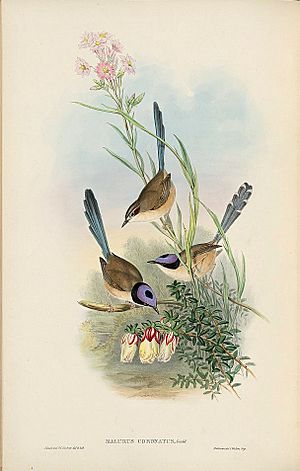
Fairywrens and Other Birds
Even though they are called fairywrens, these birds are not related to the "true wrens" found in other parts of the world. For a long time, scientists thought they belonged to different bird families. But in 1975, they were placed in their own family, Maluridae. More recent DNA studies show that the Maluridae family is related to honeyeaters (Meliphagidae) and pardalotes (Pardalotidae). These families are all part of a larger group called Meliphagoidea.
How Fairywrens Evolved
Scientists have studied the DNA of the purple-crowned fairywren. They believe this bird's family line separated from the splendid and superb fairywrens about 7 to 8 million years ago. Later, the purple-crowned fairywren separated from a group that includes the blue-breasted fairywren and variegated fairywren about 6 million years ago.
Types of Purple-Crowned Fairywrens
There are two main types, or subspecies, of the purple-crowned fairywren:
- Western purple-crowned fairywren (M. c. coronatus): This type was named by John Gould in 1858. It lives in north-western Australia.
- MacGillivray's fairywren (M. c. macgillivrayi): This type was named by Gregory Mathews in 1913. It lives in north-central Australia.
What Purple-Crowned Fairywrens Look Like
The purple-crowned fairywren is a small bird. It is about 14 cm long and has a wing-span of about 16 cm. It weighs only 9 to 13 grams. Their feathers are mostly brown. Their wings are more grayish-brown, and their belly is a creamy-buff color. They have a long, upright blue tail with white tips on most feathers. Their beak is black, and their legs and feet are brownish-grey.
There are small differences between the two subspecies. The M. c. macgillivrayi has a slightly bluer crown and upper back. The M. c. coronatus is a bit larger and has a browner back. It also has a buff-colored chest and belly instead of white.
The Male's Special Crown
During the time they breed, adult male purple-crowned fairywrens grow amazing bright purple feathers on their heads. This purple crown has a black mask around it and a black spot on top of the head. When it's not breeding season, the male's colorful crown changes to grey or brown feathers. His black mask also changes to black cheek patches with a pale ring around his eyes.
Female adult birds have a grey crown with a blue tint. They have chestnut-colored ear patches and a greenish-blue tail. Young birds look a lot like adult females but are duller in color. Young males start to show black feathers on their face when they are 6 to 9 months old.
How They Communicate
The song of the purple-crowned fairywren is different from other fairywrens. It is lower in sound and quite loud. Breeding pairs sing to each other and even sing duets to tell other fairywrens to stay out of their area. They have three main calls: a loud "cheepa-cheepa-cheepa," a quiet "chet" for talking to each other while looking for food, and a harsh "zit" for an alarm call.
Where Purple-Crowned Fairywrens Live
Their Home Range
These birds live in the wet-dry tropical areas of northern Australia. You can find them in the Kimberley region of Western Australia. They also live in the Victoria River region of the Northern Territory. And they are in the south-western coastal area of the Gulf of Carpentaria in Queensland. Even though they live across a wide area (more than 1500 km), they only live in places with good plants along rivers.
A natural barrier of about 300 km of land without suitable plants separates the two subspecies. The western subspecies (M. c. coronatus) lives along the middle parts of large rivers in the Central Kimberley Plateau and parts of the Victoria River. The eastern subspecies (M. c. macgillivrayi) lives along most rivers that flow into the south-western and southern Gulf of Carpentaria.
Their Preferred Habitat
The purple-crowned fairywren loves to live near rivers. It needs thick plants along permanent freshwater creeks and rivers. Their favorite places have lots of dense shrubs, like Pandanus aquaticus or freshwater mangroves (Barringtonia acutangula). In other areas, they like tall, thick river grass. They also need tall, dense trees like Eucalyptus camaldulensis or Melaleuca leucadendra. These tall trees are used as safe spots when floods cover the lower plants.
Purple-Crowned Fairywren Behavior and Life Cycle
Like other fairywrens, the purple-crowned fairywren is a cooperative breeder. This means that groups of birds live together and help raise the young. They stay in their territories all year round, often in lines along creeks and rivers. A group usually has a breeding pair and one to six of their older offspring. These older birds help their parents raise new chicks. They might stay with their parents for several years before they try to breed themselves. Only the main pair in a group has babies. These helpers improve how many chicks survive and also help the breeding pair live longer.
Reproduction and Nesting
Purple-crowned fairywrens can breed at any time of the year if the conditions are right. They usually have peaks in breeding from March to May and again from August to November. Most nests are found close to the ground in thick river grass or Pandanus plants. Only the female builds the small, dome-shaped nests. She uses fine roots, grass, leaves, and strips of bark.
A pair can have up to three groups of chicks (broods) each year. The female lays 2 to 3 eggs over a few days. She sits on the eggs for 14 days to keep them warm. The chicks leave the nest after 10 days. When they first fledge, they cannot fly well. They stay hidden in dense plants for about a week. Other family members feed them for at least three more weeks.
Protecting Their Territory
Groups of fairywrens keep their territories all year. They often use the same area year after year. How their territories are arranged depends on the plants in the area. In Pandanus areas, territories are usually in a line along the river, about 50 to 300 meters long. In areas with tall river grasses, territories might be spread out in a mosaic pattern.
Dangers to Nests
Many native animals might eat the eggs and young birds of the purple-crowned fairywren. These include small lizards like monitors and goannas, and snakes like the common tree snake and olive python. Some birds, like the pheasant coucal, also prey on them. Horsfield's bronze-cuckoos are also a threat. They lay their eggs in the fairywren's nests, and the cuckoo chick then pushes out the fairywren's own eggs or chicks.
Moving to New Homes
These birds usually move along waterways. On average, young purple-crowned fairywrens move less than 3 km from where they were born to find their own territory. However, some have been recorded moving up to 70 km along a river. Most of this movement happens when helpers leave their family to find their own breeding territory. Most young males stay in their home territory or move to nearby ones. Females usually move further away. Females can travel long distances and even move between different river systems.
What They Eat and How They Find Food
The purple-crowned fairywren mainly eats insects. They eat small bugs like beetles, ants, wasps, grasshoppers, moths, and spiders. They also eat small amounts of seeds. They look for food among the leaves on plants and in the leaf litter on the ground. Group members look for food separately, hopping quickly through thick plants. But they stay in touch by making soft "chet" calls.
How Long They Live
Purple-crowned fairywrens can start breeding when they are one year old. They can live up to 17 years in the wild. The oldest known wild bird lived for at least 12 years.
Threats to Purple-Crowned Fairywrens

The purple-crowned fairywren lives in small groups in scattered areas across northern Australia. This makes them vulnerable to losing even small parts of their home. The biggest threats to these birds are damage or loss of their habitat. This damage comes from animals brought into Australia, weeds, fires, floods, and mining.
Animals like cattle and sheep look for water and eat or trample the plants along rivers. These are the plants the fairywrens need for food, nesting, and shelter. More frequent or intense fires can also change the plants along rivers, which is bad for the birds. Climate change and habitat damage can also make floods worse for bird populations.
Invasive Species Dangers
Animals like feral cats and black rats are also a threat. When the plants along the river are damaged, there is less cover for the birds. This makes them easier targets for predators. In some areas, the western subspecies (M. c. coronatus) populations dropped by 50% in two years. This happened where grazing animals were allowed near their habitat. Black rats were also found to cause very low breeding success by eating nests in one area.
Conservation Status
The purple-crowned fairywren is currently listed as a Least Concern by the IUCN. This means it is not in immediate danger of disappearing globally. However, the two different subspecies are managed separately in Australia.
In 2015, the Australian Federal Government changed the status of the western subspecies from Vulnerable to Endangered. According to the IUCN Red List, the western subspecies meets the criteria for being listed as Endangered. The eastern subspecies meets the criteria for being Near Threatened.
Population Numbers
The population of M. c. macgillivrayi (eastern subspecies) might be close to 10,000 adult birds in one large group. Recent studies of M. c. coronatus (western subspecies) estimate that its total population might be as low as 10,000 birds. This is based on how much suitable habitat is left.
Past Declines
The species now lives in fewer waterways than it used to. For example, they disappeared from the lower Fitzroy River around the 1920s. This happened when sheep and cattle grazing started, and native plants were replaced by weeds. They also disappeared from a large part of the Ord River after a dam was built and the area flooded. More recently, a study in the Victoria River region showed that populations are still declining. This is due to heavy cattle grazing along riverfronts.
The western subspecies (M. c. coronatus) has lost a lot of its original living area over the last 140 years. It now only lives in limited parts of six river systems. Declines in other areas are likely because the condition of river areas is getting worse.
Protecting Purple-Crowned Fairywrens
Protecting the plants along rivers is very important to help these birds survive. Active conservation is more urgent for the Endangered M. c. coronatus. Only 17% of its habitat in the Kimberley Region is in protected areas. Small populations on the northern Pentecost and Isdell Rivers are at the highest risk of disappearing. They need urgent, specific help to save them.
A plan is needed to connect the birds' living areas and stop the ongoing damage to river plants. Here are some suggested actions:
- Control how much livestock and other introduced animals can access river areas.
- Keep livestock out of river areas.
- Reduce the number of intense fires that harm sensitive river plants by using better fire management.
- Control the spread of weeds by finding and removing them.
- Preserve good quality river habitat, both inside and outside protected areas.
- Restore river habitat, especially in high-risk areas.
Conservation Efforts in Action
The Department of Agriculture and Food Western Australia (DAFWA) has worked with Wungurr Rangers and farmers in the north-west Kimberley. They are trying to protect parts of the fairywren's habitat by removing a harmful plant called Ornamental rubbervine.
The Australian Wildlife Conservancy (AWC) is also protecting river plants on its Mornington-Marion Downs and Pungalina-Seven Emu sanctuaries. They have a program called EcoFire to manage fires and control introduced animals. EcoFire is a large-scale fire management program that covers four million hectares. It helps protect the fire-sensitive plants that are vital for the purple-crowned fairywren's survival.
Images for kids
See also
 In Spanish: Maluro coronado para niños
In Spanish: Maluro coronado para niños



